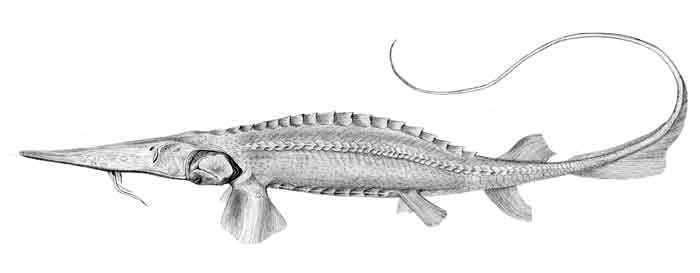Superregnum: Eukaryota
Cladus: Unikonta
Cladus: Opisthokonta
Cladus: Holozoa
Regnum: Animalia
Subregnum: Eumetazoa
Cladus: Bilateria
Cladus: Nephrozoa
Superphylum: Deuterostomia
Phylum: Chordata
Subphylum: Vertebrata
Infraphylum: Gnathostomata
Megaclassis: Osteichthyes
Superclassis/Classis: Actinopterygii
Classis/Subclassis: Actinopteri
Subclassis/Infraclassis: Chondrostei
Ordo: Acipenseriformes
Familia: Acipenseridae
Subfamilia: Scaphirhynchinae
Genus: Pseudoscaphirhynchus
Species (3): P. fedtschenkoi – P. hermanni – P. kaufmanni
Name
Pseudoscaphirhynchus Nikolskii, 1900

Pseudoscaphirhynchus fedtschenkoi
References
Pseudoscaphirhynchus – Taxon details on Integrated Taxonomic Information System (ITIS).
Pseudoscaphirhynchus is a genus of relatively small, highly threatened sturgeons that are restricted to the Aral Sea system (although extirpated from the Aral Sea itself), including the Amu Darya and Syr Darya river basins, in Central Asia.[3][4]
P. fedtschenkoi is restricted to Syr Darya, but has not been seen in decades and it is possibly extinct.[5][6] The two other species in the genus are restricted to Amu Darya: P. hermanni survives in very low numbers and P. kaufmanni in low numbers, with both being rated as Critically Endangered by the IUCN.[7][8][9][10]
Compared to other sturgeons, Pseudoscaphirhynchus are small. The largest species, P. kaufmanni, reaches up to 75 cm (30 in) in total length (excluding tail filament), while the smallest, P. hermanni, only reaches 27.5 cm (10.8 in), making it the smallest member of the sturgeon family.[4][9] P. kaufmanni has a long thin tail filament, P. hermanni lacks it, and it can be long or short in P. fedtschenkoi.[9] They have a relatively long, broad and flattened snout, somewhat like Scaphirhynchus of North America. Little is known about the behavior of Pseudoscaphirhynchus, but they mainly feed on the bottom on small fish and aquatic insect larvae.[11]
Taxonomy and species
Three different P. hermanni seen from above
There are currently three recognized species in this genus:[4]
Pseudoscaphirhynchus fedtschenkoi (Kessler, 1872) (Syr Darya sturgeon)
Pseudoscaphirhynchus hermanni (Kessler, 1877) (dwarf sturgeon, small Amu Darya sturgeon)
Pseudoscaphirhynchus kaufmanni (Kessler, 1877) (Amu Darya sturgeon)
Historically, the two species in the Amu Darya River were known to hybridize.[11] Unusually, P. fedtschenkoi occurs (or occurred) in three morphs that can be separated by the length of their snout and tail filament, and P. kaufmanni occurs in two morphs that can be separated by their total size and colour.[9][10][11]
Although Pseudoscaphirhynchus and Scaphirhynchus traditionally are placed together in the subfamily Scaphirhynchinae based on their similar morphology, several genetic and karyotypic studies have shown that this grouping is polyphyletic.[10][11][12]
References
fish portal
Froese, R.; Pauly, D. (2017). "Acipenseridae". FishBase version (02/2017). Retrieved 18 May 2017.
"Acipenseridae" (PDF). Deeplyfish- fishes of the world. Retrieved 18 May 2017.
"ITIS - Report: Pseudoscaphirhynchus".
Froese, Rainer and Pauly, Daniel, eds. (2019). Species of Pseudoscaphirhynchus in FishBase. May 2019 version.
Mugue, N. (2010). "Pseudoscaphirhynchus fedtschenkoi". IUCN Red List of Threatened Species. 2010: e.T18599A8496937. doi:10.2305/IUCN.UK.2010-1.RLTS.T18599A8496937.en. Retrieved 23 May 2019.
Mitrofanov, I.V.; and N.Sh. Mamilov (2015). Fish diversity and fisheries in the Caspian Sea and Aral–Syr Darya basin in the Republic of Kazakhstan at the beginning of the 21st Century. Aquatic Ecosystem Health & Management 18(2): 160–170. doi:10.1080/14634988.2015.1028870
Mugue, N. (2010). "Pseudoscaphirhynchus hermanni". IUCN Red List of Threatened Species. 2010: e.T18600A8497165. doi:10.2305/IUCN.UK.2010-1.RLTS.T18600A8497165.en. Retrieved 23 May 2019.
Mugue, N. (2010). "Pseudoscaphirhynchus kaufmanni". IUCN Red List of Threatened Species. 2010: e.T18601A8498207. doi:10.2305/IUCN.UK.2010-1.RLTS.T18601A8498207.en. Retrieved 23 May 2019.
Salnikov, V.B.; V.J. Birstein; and R.L. Mayden (1996). The contemporary status of the two Amu Darya River shovelnose sturgeons, Pseudoscaphirhynchus kaufmanni and P. hermanni. The Sturgeon Quarterly 4(3): 10–14.
Kovalev, K.V.; D.A. Balashov; A.L. Cherniak; E. B. Lebedeva; E.D. Vasil'eva; and V.P. Vasil'ev (2016). The karyotype of the Amu Darya sturgeon, Pseudoscaphirhynchus kaufmanni (Actinopterygii: Acipenseriformes: Acipenseridae). Acta Ichthyologica Et Piscatoria 44(2): 111-116.
Birstein, V.J.; J.R. Waldman; and W.E. Bemis, editors (1997). Sturgeon biodiversity and conservation, pp. 146, 381–382. Kluwer Academic Publishing. ISBN 0-792-34517-7
Sheraliev, Bakhtiyor; Peng, Zuogang (2020). "Complete mitochondrial genome sequence and phylogenetic position of the Amu Darya sturgeon, Pseudoscaphirhynchus kaufmanni (Acipenseriformes: Acipenseridae)". Journal of Applied Ichthyology. 36 (4): 389–392. doi:10.1111/jai.14043. S2CID 219007942.
Retrieved from "http://en.wikipedia.org/"
All text is available under the terms of the GNU Free Documentation License

